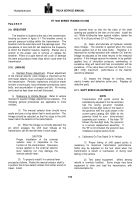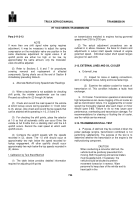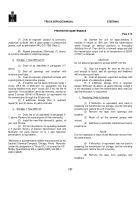TM-5-3805-254-14-P-2 - Page 708 of 894
TRUCK SERVICE MANUAL
PREVENTIVE MAIETENANCE
Para 3-7/3-8
c. After draining is completed, remove 23 washer-
head screws 33 (A, foldout 14)that retain the oil pan to
the transmission housing. Discard pan gasket 29 and
clean the pan with mineral spirits or paint thinner.
d. Remove
washer-head screw 28 (A, foldout 14)
and washer 27, and remove the oil filter (and spacer 26
on later models).
Discard the filter.
e. Prior to installing the new filter, install a new
seal-ring 24 (A, foldout 14) onto the oil intake pipe
(integral with filter).
Lubricate the seal-ring with
transmission fluid.
f. Install the new oil filter (aligned so that filter does
not require twisting), inserting the oil intake pipe into the
hole in the bottom of the transmission.
Secure the oil
filter with a 5/16-18 x 5/8-inch, washer-head screw.
Tighten the screw to 10 to 13 pound feet (14 to 18 Nm)
torque.
g.
Place the oil pan gasket onto the oil pan.
Do not use
any substance as a gasket retainer.
CAUTION
Do
not
use
gasket-type
sealing
compounds
any
place
inside
the
transmission or where they might get
washed into the transmission.
Also, only
oil-soluble greases may be used (except
oil pan gasket)for temporarily retaining
parts during assembly.
Nonsoluble
vegetable base cooking compounds or
fibrous greases must not be used inside
the transmission.
h. Install the oil pan and gasket, carefully guiding
them into place.
Guard against dirt or foreign material
entering the pan.
Retain the pan to the housing with four
5/16-18 washer-head screws.
Install each screw, by
hand, one at a time, into each corner of the pan.
i. Install the remaining 19 washer-head screws by
hand, carefully threading each one through the gasket.
Bottom all screws before tightening them.
j.
Alternately tighten screws 180° apart to 5 pound
feet (8 Nm) torque.
Repeat the process tightening the
screws to 10 to 13 pound feet (14 to 18 Nm) torque.
k. Install the filler tube at the side of the pan.
On
later models install the oil drain plug at the rear of the
pan.
l. Remove the dipstick and pour approximately 26
US quarts (24.6 litres) of transmission fluid into the
transmission through the filler tube.
Then check the oil
level using the procedure described in paragraph 3-3.
3-8.
OIL CONTAMINATION
a. Examine at Oil Change.
At each oil change,
examine the oil which is drained for evidence of dirt or
water.
A normal amount of condensation will emulsify in
the oil during operation of the transmission.
However, if
there is evidence of water, check the cooler (heat
exchanger) for leakage between the water and oil areas.
Oil in the water side of the cooler (or vehicle radiator) is
another sign of leakage.
This, however, may indicate
leakage from the engine oil system.
Any accumulation of
sludge or soft dirt in the sump should be removed.
b. Metal Particles.
Metal particles in the oil (except
for the minute particles normally trapped in the oil filter)
indicate damage has occurred in the transmission.
When these particles are found in the sump, the
transmission must be disassembled and closely
inspected to find the source.
Metal contamination will
require complete disassembly of the transmission and
cleaning of all internal and external circuits, cooler, and
all other areas where the particles could lodge.
c. Coolant Leakage.
If engine coolant leaks into
the transmission oil system, immediate action must be
taken to prevent malfunction and possible serious
damage.
The transmission must be completely
disassembled, inspected and cleaned.
All traces of the
coolant, and varnish deposits resulting from coolant
contamination, must be removed.
Water and/or coolant
contamination will cause rapid deterioration of resin-
graphite clutch plates.
701
TRANSMISSION
Back to Top




















